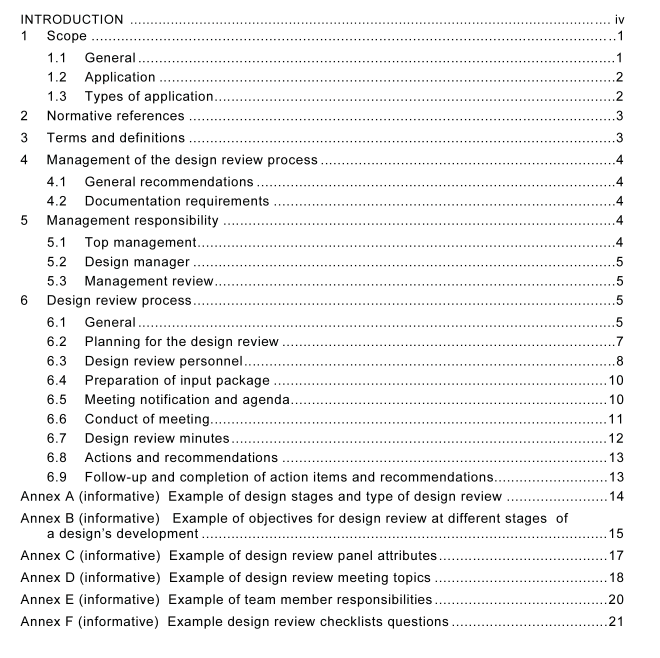AS IEC 61160 pdf – Design review

AS IEC 61160 pdf – Design review
6.6 Conduct of meeting
6.6.1 General If the panel members are not experienced in design reviews, an orientation session should be conducted explaining the general objectives, philosophy, and practice. The introductory comments should set a constructive tone and climate. The chair should review the objectives of the meeting and relate them to the overall objectives and procedures for the design review process. The chair should stress the need to ask questions and to avoid negative and personally oriented comments.
Questions that imply pre-judgement should be avoided. Panel members should feel free to question their peers. They should not see their responsibility as being solely to ask why something was done in a particular way. Whenever necessary, the review participants should be assured that all questions raised, subsequent investigations requested, and opinions expressed do not reflect on anyone’s personality, ability or integrity. The entire team, under the direction of the chair, should ensure that the design review process does not become a personality contest either among the panel members or between the panel and the design team. The panel members should always remember that they serve in an advisory capacity and that their prime purpose is to assist those responsible for the product’s design in achieving the optimum result. They are not there to provide a solution to any deficiencies identified.
6.6.2 Presentations The design manager and the other members representing the design and development team should present, as required, aspects of the design under review.
6.6.3 Meeting protocol The chair should ensure that presentation and questioning proceed systematically. The review process is one of constructive questions and answers. Derogatory questions or responses should not be permitted, nor should there be a flat refusal to discuss a topic unless there are specific issues of commercial confidentiality or national security involved. Questions should be framed in terms of requests for information or inquiry as to reasons for design and development decisions. Panel members can submit questions to the chair in advance to allow for a prepared response. These questions can be considered complex or minor. To facilitate progress of the meeting, minor questions can be closed before start of the meeting. These questions would be a part of the meetings input package.
Typographical errors, or minor editorial matters relating to the input data themselves should not be discussed at the design review. The secretary should arrange for correction of these as needed. Any substantive corrections should be discussed review participants. The design review process should not confer approval or disapproval of the design and development documents reviewed. 6.6.4 Action items Whenever an action is required, the name of the person assigned, the task given and the date for response should be recorded in the meeting’s minutes. As the status of the review panel is advisory, the design manager determines the response to any action items.
6.6.5 Recommendations All recommendations should be described in detail in the meeting’s minutes, and related to the original discussion. The reasons for a recommendation should be recorded wherever possible. Recommendations are not the same as action items but actions could result at a later date.
6.6.6 Rejected action items and recommendations For action items originating from previous design reviews and not completed, and for rejected recommendations, the reasons for inaction or rejection should be explained and documented.
6.6.7 Meeting conclusion At the conclusion of the meeting the chair should summarise the actions and recom- mendations arising from the review to ensure a common understanding and agreement by the team.
6.7 Design review minutes
6.7.1 General Reasons for minutes for design review meetings include the need to:
• provide a means for follow-up of action items and recommendations;
• record the organisation’s corporate knowledge and experience;
• create a record to assist in establishing the state of the design at a point in time and record the development history of the product or process. This can be useful in protecting patent and other property rights and in defending the product and its development process against subsequent inquiry and legal proceedings. The design review minutes and supporting documents should be retained in accordance with the document control procedures for the organisation’s design and development documents. The meeting’s minutes should be sent to the design manager and the members of the design review panel.









